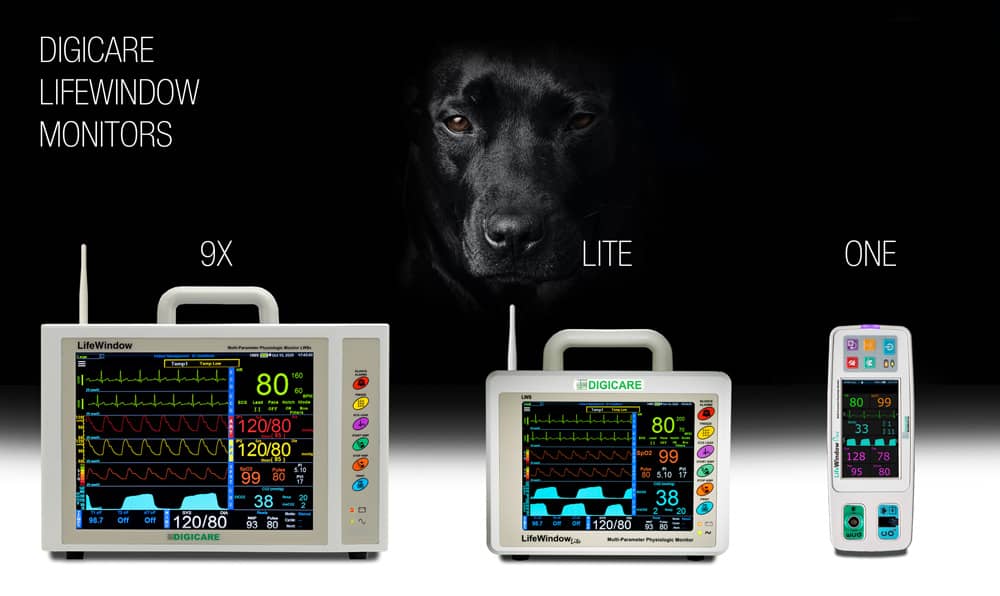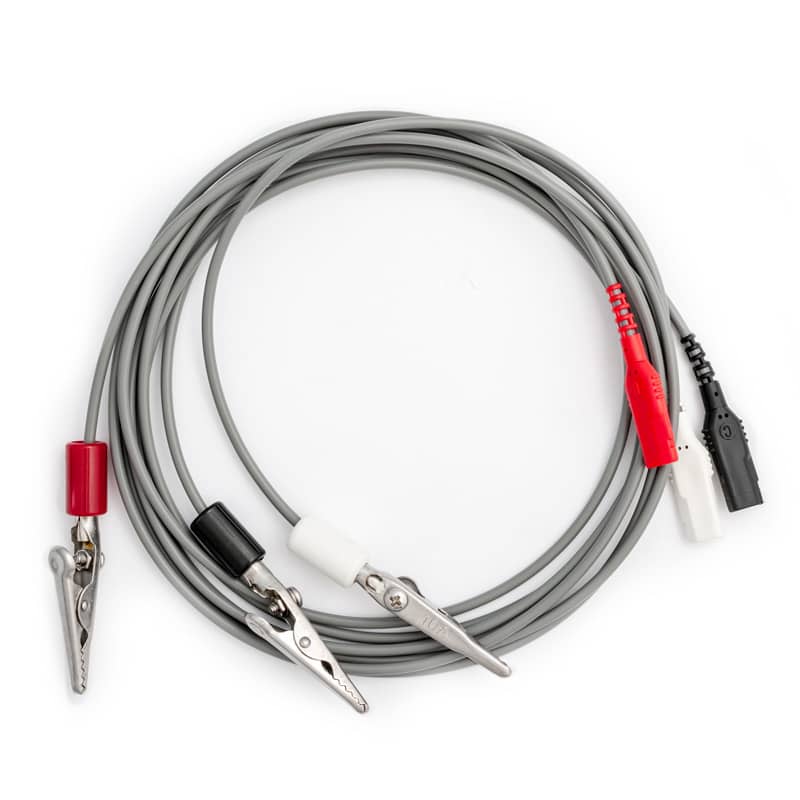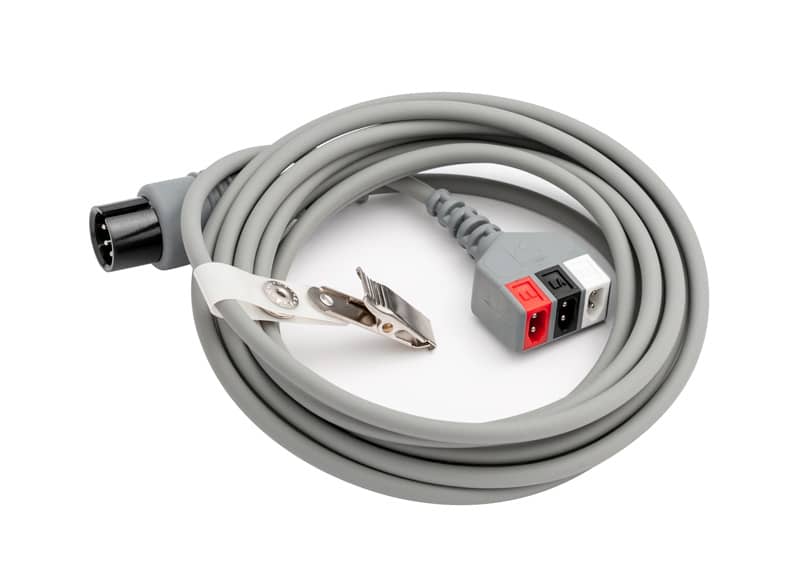
**All accessories may be cleaned with diluted alcohol or a mild cleaner on gauze or cotton**
LW8 LITE
and 9x Models
ECG
(Keep attached to monitor and hang leads and cable)
LEADS: For these monitors, you can either have the 3 lead alligator clips (255-EC003) or the 3 lead snap-in smooth clips (255-EC014). ECG leads should be replaced as needed or approximately every 2 years to maintain good contact.
LW1 Model
ECG
(Keep attached to monitor and hang leads and cable)
LEADS: (255-EC015) ECG leads should be replaced as needed, if fraying is seen, or approximately every 2 years.
CABLE: (255-EC024) Replace cable every 3-5 years or as needed.
LW8 LITE, 9x and LW1 Models
SPO2
(Keep attached to monitor and hang sensors and cable).
SENSOR: The technology of this SpO2 is Masimo. Please be sure when using the lingual area to relocate the sensor’s position every 30 minutes to avoid pressure necrosis. This sensor will usually last about 8-12 months depending on use. Replace if fraying or if “replace sensor” message is seen. Use care when handling and cleaning and do not submerge into the liquid to avoid damaging the sensor.
OPTIONAL SENSORS:
PATIENT CABLE: Clean with diluted alcohol or a mild cleaner. Replace every 3-5 years or as needed or when damaged or “replace cable” message is seen. Connector type: RD-Set (255-PO800).
LW8 LITE, 9x and LW1 Models
SIDESTREAM CO2
(This is the only accessory you should remove daily from the monitor).
There are 4 different sample lines that can be used. Sample lines are good for approximately 72hrs of use. We recommend when you open a new sample line to use a piece of tape to put the date on the line. Replace line if “occlusion error” is seen, has visible cuts or damage, or if moisture gets into the line. Do not submerge in liquids.
All sample lines should be rotated between surgeries to give the line time to dry. We recommend hanging lines with the mouthpiece down and filter towards the ceiling to allow all the moisture to drain down to the mouthpiece.
External Respironics CO2 Sidestream Module (255-CAP100).
LW8 LITE and 9x Models
Perform a zero calibration when placing a new sample line, when switching between sizes, when the readings seem off or you see a “no breaths” message.
- This must be done off the patient and input exposed to 0 mmHg CO2 concentration.
- To do this, disconnect the sample line from the patient’s track tube and allow 20 seconds for the CO2 to clear the line then click on the CO2, then Zero.
- The monitor will ask if the input is exposed to 0 mmHg, click yes. You will see “zero in progress” on the screen then when the zero is finished, the numbers will flash, and you are ready to use.
- If you receive a “zero error” message, repeat the process or try a new sample line.
- If you receive an “occlusion” message, this means that moisture has hit the filter and you will need to replace the sample line.
LW1 Model
Perform a zero calibration when placing a new sample line, when switching between sizes, when the readings seem off or you see a “no breaths” message.
- This must be done off the patient and input exposed to 0 mmHg CO2 concentration.
- To do this, disconnect the sample line from the patient’s track tube and allow 20 seconds for the CO2 to clear the line then in the main menu click on CO2 settings, then Zero.
- You will see “zeroing” at the top left corner of the screen then when the “zeroing” is finished, the numbers will flash, and you are ready to use.
- If you receive a “zero error” message, repeat the process or try a new sample line.
- If you receive an “occlusion” message, this means that moisture has hit the filter and you will need to replace the sample line.
LW8 LITE, 9x and LW1 Models
Types of lines:
High humidity
(255-CAP120) for trach tubes over 4.
Recommended for general surgery.
High humidity, low dead space
(255-CAP123) for trach tubes under 4.
Recommended for general surgery.
Low humidity
(255-CAP121) for trach tubes over 4.
Recommended for dental.
Low humidity, low dead space
(255-CAP122) for trach tubes under 4.
Recommended for dental.
Luer lock/Low Humidity Equine
(255-CAP124) Trach tube above 4.
Recommended for dental cleanings or oral surgery.
Luer lock/High Humidity Equine
(255-CAP125) Trach tube above 4.
Recommended for general surgery.
LW8 LITE and 9x Models
MAINSTREAM CO2
Respironics CO2 Mainstream Sensor, Capnostat 5 (255-CAP101).
(Keep mainstream sensor attached to monitor and remove adapters only).
Though considered disposable (255-CAP112 & 255-CAP113), in the veterinary field these are reused and recommended to be changed every 4-6 months. Please note if the adapter becomes broken or cracked it must be changed immediately and it is always best to keep extra on hand in your clinic.
Airway Adapter
Disposable Regular Dead Space: Trach tube above 4, all surgeries and dental (255-CAP112).
Airway Adapter
Disposable Low Dead Space: Trach Tube under 4, all surgeries and dental (255-CAP113).
Airway Adapter
Low Dead Space Reusable: Trach tube under 4, all surgeries and dental (CAP111).
*Autoclavable* Airway Adapter
Regular Dead Space Reusable: Trach tube above 4, all surgeries and dental (255-CAP112).
*Autoclavable*
Please perform zero-calibration when moving from regular dead space to low dead space adapters and vice versa. *Please – find directions for zero-calibration above*.
LW8 LITE, 9x and LW1 Models
NIBP
(Keep attached to monitor and wrap loosely next to monitor or in a basket or drawer).
LW8 LITE, 9x and LW1 Models
TEMP
(Keep attached to monitor and hang).
REUSABLE TEMP PROBE (255-TP004)
This probe has a sensor at the tip of the probe. Please be careful when placing this sensor to not hit hard feces or a wall in the rectum. This sensor usually lasts about 8-12 months depending on use. If the tip of the sensor is cracked or broken, please replace it. Plastic disposable probe covers are available in boxes of 100, (255-PO732).

LW8 LITE, 9x and LW1 Models
Masimo Transflectance Sensor
The transflectance sensor is a great option for use in dental procedures or oral surgery as it attaches to the base of the tail just above the rectum using Vetrap. It is important that the emitter and receiver touch directly onto the skin so you might have to do a light clip of hair around the ventral tail.
Use vet wrap to place the sensor on the ventral base of the tail either transversely on a wide based tail or longitudinally if a narrow based tail so that it can hit a coccygeal bone and bounce back.
The transflectance sensor requires more technique to use than the lingual sensor.
Tips for using the transflectance sensor are:
If you wrap this sensor too tightly, you may impede perfusion to the sensor site. Wrap this sensor so that it is “snug”. If the sensor is wrapped too loosely, it may move and display erroneous readings.
LW8 LITE, 9x and LW1 Models
Optional Site
TFI sensor on the metatarsal*.
There is a spot immediately behind the large pad that has a slight indentation. Remove the hair and wrap the ankle securely, without too much pressure, and wait 10 to 15 seconds to see if you get a good pulse signal every time the heart beats.
Utilize the PI and SIQ bar to help optimize sensor placement. If SIQ and PI are RED reposition the sensor or try another site. If SIQ and PI are GREEN secure sensor in place with wrap.
Small Dogs
PVI, SpO2, HR, and PI monitoring in Small Dogs (less than 60-70 lbs.) using TCI on the Tongue. If you have small size dogs (less than 60-70 lbs.), then double folding their tongue to itself so that you can increase the thickness of the tongue tissue.
After such folding, then place the lingual probe over the thickening tongue. It is essential that the emitter and receiver are parallel. You should be able to get better PI and roughly after 3-4 minutes later you can get readings from PVI.
Large Dogs
PVI, SpO2, HR, and PI monitoring in Large Dogs using TCI on the Tongue. When monitoring SpO2, HR, and PI only in Large Dogs (greater than 70 lbs.) place the Lingual TCI clip sensor on the tongue. Make sure the tip of the tongue is touching the inner base of the sensor and ensure the emitter and receiver are parallel.
Video for the LifeWindow monitor.
Related Products
-

SunTech Single Use Cuffs for Digicare Monitors
-

SunTech Reusable Cuffs for Digicare Monitors
-

NIBP Hose for SunTech Cuff
-

External Respironics CO2 Sidestream Module
-

CO2 Respironics Sample Line – Luer Lock (Equine) High Humidity
-

ECG 3 cable and leads with smooth clips for Digicare PocketSigns
-

CO2 Respironics Sample Line Low Humidity, Low Dead Space
-

LifeWindow LW9xVet Monitor





























